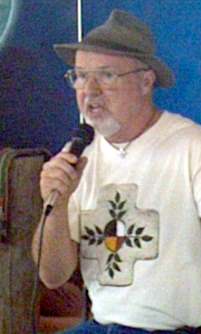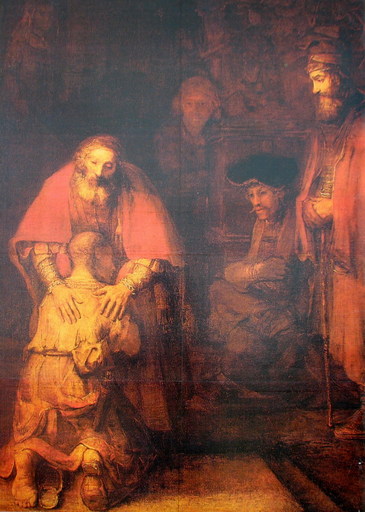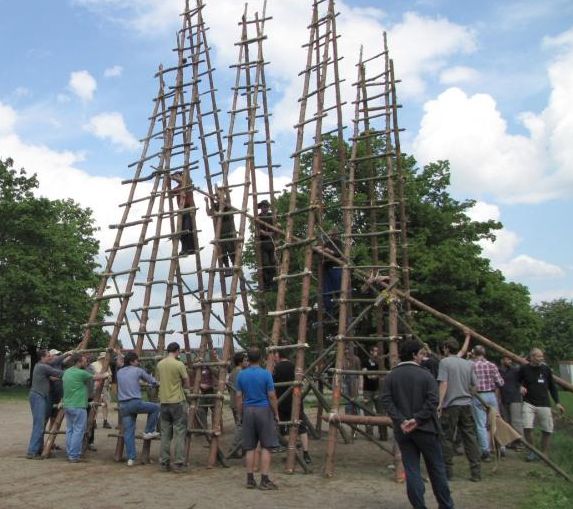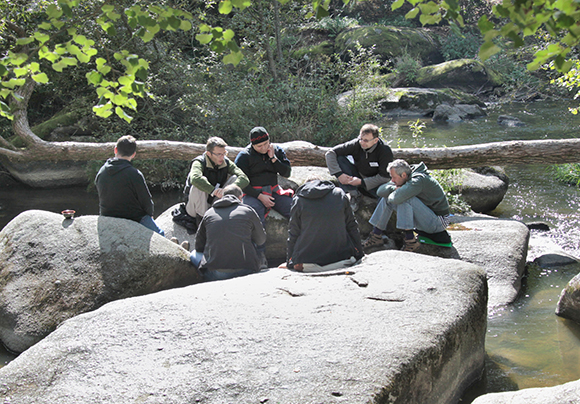
Starý muž, který se neumí smát, je trouba.
Richard Rohr
Kdo jsme?
Tento web reprezentuje hnutí Chlapi, neformální společenství mužů, kteří hledají takové způsoby duchovního prožívání, se kterými se dokážou jako muži ztotožnit a celou bytostí je žít.
Můžeš se tady setkat s muži, kteří usilují o to být lepšími a více autentickými.
Vytváříme jak reálný tak virtuální prostor pro setkávání.
Začalo to někdy před rokem 2000 hledáním mužské energie, spirituality i chlapské party a setkáváním v malých skupinách. Pokračovalo to inspirací dílem Richarda Rohra a jeho Rituálem pro přechod do zralé dospělosti a pokračuje to dodnes stovkami setkání v malých skupinách, víkendovými akcemi pro muže i pro otce a děti, rituály i celostátními setkáními pro stovky účastníků a mezinárodní spoluprací s hnutím mužů po celém světě.
Pro řadu z nás je podstatné přátelství s Bohem, pro všechny jsou oporou kamarádi, které tu nalezli.
Vítáme tě mezi námi a těšíme se na společné putování.

Pavel Hrdina a Martin Šmídek
Překlad meditace CAC ze čtvrtka 9. 3. 2023
na téma:
Poutě
| Cesta srdce Neboť kde je tvůj poklad, tam bude i tvé srdce. -Matouš 6:21 Autorka Sheryl Kujawa-Holbrooková spojuje poutnictví s univerzálními touhami našich srdcí: První, co všechny lidské bytosti v děloze slyší, je tlukot matčina srdce. Metafora cesty do středu srdce nabízí mnoho vhledů do podstaty poutnictví obecně a zejména vnitřní cesty poutníka. Jedno z poutních míst, které vypovídá o cestě do středu srdce, se nachází v malé vesnici Chimayó v horách na severu Nového Mexika. "Jsi-li cizincem, jsi-li unaven životními zápasy ... ať už máš zlomené srdce, vydej se po dlouhé horské cestě, najdi domov v Chimayó." [1] ... Mnozí poutníci, kteří tam putují, nemusí nutně patřit ke stejné náboženské tradici a často nejsou zcela oddáni poutní tradici nebo nutně nevěří v zázračné uzdravení. Na pouť se však vydávají proto, že v srdci cítí touhu a něco hledají - možná božskou lásku nebo vnitřní klid, úlevu od zlomeného srdce nebo smysluplnější život - a útěchu získávají tím, že se na cestě připojí ke skupině poutníků.... Putování tedy zahrnuje... srdce. Talmud říká, že "Bůh chce srdce". Je to srdce, které drží tělo pohromadě..... Augustin z Hippo [354-430] napsal, že srdce je metaforou našeho nejhlubšího a nejopravdovějšího já, a často tento obraz používá jako způsob, jak vysvětlit svou vlastní cestu k Bohu: "Stvořil jsi nás pro sebe a naše srdce je neklidné, dokud nespočine v tobě." [2] Kujawa-Holbrook píše o propletených cestách, kterými nás pouť provází: Svaté umění pouti zahrnuje jak vnitřní, tak vnější cestu..... Poutník se snaží udržet vnitřní i vnější cestu pohromadě, někdy v napětí, ale vždy zaměřenou na hledání smyslu, na hledání božského.... To, co nejvíce odlišuje posvátné umění poutě od turistického výletu nebo pěší výpravy, jakkoli jsou přínosné, je charakteristická cesta dovnitř, obrácení srdce k Bohu, s očekáváním proměny na všech úrovních bytí na této cestě. Benedikt z Nursie [asi 480-547], zakladatel západního mnišství a autor benediktinské řehole, radil svým mnichům a mniškám, aby "naslouchali uchem svého srdce". [3] Jinými slovy, první touha poutníka je v srdci, hluboko a uvnitř, někdy i několik let předtím, než začne vnější cesta. Fr. Richard Rohr, OFM přeloženo DeepL | A Journey of the Heart
For where your treasure is, there your heart will be also. —Matthew 6:21 Author Sheryl Kujawa-Holbrook connects pilgrimage to the universal longings of our hearts: The first thing all human beings hear in the womb is their mother’s heartbeat. The metaphor of a journey to the center of the heart offers many insights into the nature of pilgrimage in general and the inward journey of the pilgrim in particular. One pilgrimage site that speaks to the journey to the center of the heart is found in the small village of Chimayó, located in the mountains of northern New Mexico. “If you are a stranger, if you are weary from the struggles of life … whether you have a broken heart, follow the long mountain road, find a home in Chimayó.” [1] … Many of the pilgrims who travel there are not necessarily of the same religious tradition, and they are often not totally committed to the pilgrimage tradition or necessarily believe in miraculous healing. But they go on pilgrimage because they feel a longing in their hearts, and they are searching for something—perhaps divine love or inner peace, relief from a broken heart, or a more meaningful life—and they gain solace from belonging to a group of pilgrims along the way…. Pilgrimage, then, involves … the heart. The Talmud says, “God wants the heart.” It is the heart that holds the body together…. Augustine of Hippo [354–430] wrote that the heart is a metaphor for our deepest and truest selves, and he frequently uses the image as a way to explain his own journey to God: “You have made us for yourself, and our heart is restless until it rests in you.” [2] Kujawa-Holbrook writes of the interwoven journeys that pilgrimage takes us through: The sacred art of pilgrimage involves both an inward and outward journey…. The pilgrim strives to hold both the inward and outward journey together, sometimes in tension, but always focused on the search for meaning, for the Divine…. What most distinguishes the sacred art of pilgrimage from a tourist trip or hiking expedition, as beneficial as these are, is the characteristic inward journey, a turning of one’s heart to the Divine, with the expectation of transformation on every level of being along the way. Benedict of Nursia [c. 480–547], the founder of Western monasticism and author of the Benedictine Rule, used to advise his monks and nuns to “listen with the ear of their heart.” [3] In other words, the pilgrim’s first yearning is in the heart, deeply and inwardly, sometimes for years before the outward journey begins. Fr. Richard Rohr, OFM |
[1] George Mendoza, poem written at Chimayó, 1974, in Running toward the Light: The George Mendoza Story, William J. Buchanan (Albuquerque, NM: University of New Mexico Press, 2006), 85.
[2] Augustine, Confessions, bk. 1.1, trans. Henry Chadwick (New York: Oxford University Press, 2008), 3.
[3] The Rule of Saint Benedict, prologue.
Sheryl A. Kujawa-Holbrook, Pilgrimage—the Sacred Art: Journey to the Center of the Heart (Woodstock, VT: SkyLight Paths, 2013), 40–41, 42, 43, 44–45.
Zde se nacházejí překlady Daily Meditations, jejichž anglické originály se nacházejí na webu CAC. V den jejich vydání je zde nalezneš přeložené strojově pomocí DeepL, zpravidla do druhého dne pak projdou jazykovou úpravou někým z týmu překladatelů :-) Pokud vládneš dobrou angličtinou, přihlas se asi raději přímo u zdroje těchto úvah, tedy na webu CAC. Budeš je pak do své mailové schránky dostávat již k ranní kávě. -mš-
 Myšlenka Richarda Rohra na pondělí 4. týdne adventního - Jsem úplná absurdita a paradox Lidé jsou podivná stvoření; jsme současně velmi dobří i velmi hříšní. Tyto vlastnosti se vzájemně neruší. Víra znamená žít a vydržet v tomto paradoxu. Ti, kdo mají prostor, aby v nich mohly koexistovat tyto dvě zdánlivě protichůdné pravdy, jsou ti, kdo dokáží rozpoznat Boží království. Absurdnost lidské skutečnosti je nešokuje; …
Myšlenka Richarda Rohra na pondělí 4. týdne adventního - Jsem úplná absurdita a paradox Lidé jsou podivná stvoření; jsme současně velmi dobří i velmi hříšní. Tyto vlastnosti se vzájemně neruší. Víra znamená žít a vydržet v tomto paradoxu. Ti, kdo mají prostor, aby v nich mohly koexistovat tyto dvě zdánlivě protichůdné pravdy, jsou ti, kdo dokáží rozpoznat Boží království. Absurdnost lidské skutečnosti je nešokuje; …




